Potential Suitable Habitat of Two Economically Important Forest Trees (Acer truncatum and Xanthoceras sorbifolium) in East Asia under Current and Future Climate Scenarios
Abstract
:1. Introduction
2. Materials and Methods
2.1. Species Occurrence Data
2.2. Study Regions
2.3. Environmental Variables
2.4. Assessment of Current and Future Habitats
3. Results
3.1. Accuracy Test
3.2. Important Environmental Variables
3.3. Current Potential Suitable Habitats
3.4. Future Potential Suitable Habitats
3.5. Centroid Transition
4. Discussion
5. Conclusions
Author Contributions
Funding
Data Availability Statement
Acknowledgments
Conflicts of Interest
Appendix A
| A. truncatum (km) | X. sorbifolium (km) | |||||
|---|---|---|---|---|---|---|
| Current | 2050s | 2070s | Current | 2050s | 2070s | |
| RCP2.6 | 117.012° E, 37.671° N | 118.003° E, 39.593° N | 117.819° E, 38.786° N | 112.441° E, 37.942° N | 113.208° E, 38.872° N | 112.464° E, 38.642° N |
| RCP4.5 | 117.012° E, 37.671° N | 118.243° E, 39.455° N | 118.805° E, 39.702° N | 112.441° E, 37.942° N | 112.890° E, 38.805° N | 112.857° E, 39.047° N |
| RCP6.0 | 117.012° E, 37.671° N | 118.622° E, 39.362° N | 118.575° E, 39.675° N | 112.441° E, 37.942° N | 112.919° E, 38.805° N | 112.808° E, 38.849° N |
| RCP8.5 | 117.012° E, 37.671° N | 118.820° E, 39.825° N | 119.721° E, 40.572° N | 112.441° E, 37.942° N | 113.091° E, 39.020° N | 113.096° E, 39.327° N |
| Current to 2050s | 2050s to 2070s | Current to 2070s | Current to2050s | 2050s to 2070s | Current to 2070s | |
| RCP2.6 | 230.4 | 91.12 | 142.62 | 123.13 | 69.4 | 77.86 |
| RCP4.5 | 225.4 | 55.45 | 274.25 | 103.64 | 27.06 | 128.09 |
| RCP6.0 | 234.46 | 35.04 | 260.88 | 104.62 | 10.79 | 105.8 |
| RCP8.5 | 286.25 | 112.94 | 398.28 | 132.55 | 34.14 | 164.18 |
References
- Berthel, N.; Schworer, C.; Tinner, W. Impact of Holocene climate changes on alpine and treeline vegetation at Sanetsch Pass, Bernese Alps, Switzerland. Rev. Palaeobot. Palynol. 2012, 174, 91–100. [Google Scholar] [CrossRef]
- Pounds, J.A.; Bustamante, M.R.; Coloma, L.A.; Consuegra, J.A.; Fogden, M.P.L.; Foster, P.N.; La Marca, E.; Masters, K.L.; Merino-Viteri, A.; Puschendorf, R.; et al. Widespread amphibian extinctions from epidemic disease driven by global warming. Nature 2006, 439, 161–167. [Google Scholar] [CrossRef] [PubMed]
- Qin, H.; Dong, G.; Zhang, Y.B.; Zhang, F.; Wang, M.B. Patterns of species and phylogenetic diversity of Pinus tabuliformis forests in the eastern Loess Plateau, China. For. Ecol. Manag. 2017, 394, 42–51. [Google Scholar] [CrossRef]
- Fitzpatrick, M.C.; Gove, A.D.; Sanders, N.J.; Dunn, R.R. Climate change, plant migration, and range collapse in a global biodiversity hotspot: The Banksia (Proteaceae) of Western Australia. Glob. Chang. Biol. 2008, 14, 1337–1352. [Google Scholar] [CrossRef]
- Lawler, J.J.; Shafer, S.L.; White, D.; Kareiva, P.; Maurer, E.P.; Blaustein, A.R.; Bartlein, P.J. Projected climate-induced faunal change in the Western Hemisphere. Ecology 2009, 90, 588–597. [Google Scholar] [CrossRef] [PubMed] [Green Version]
- Thuiller, W.; Lavorel, S.; Araujo, M.B.; Sykes, M.T.; Prentice, I.C. Climate change threats to plant diversity in Europe. Proc. Natl. Acad. Sci. USA 2005, 102, 8245–8250. [Google Scholar] [CrossRef] [PubMed] [Green Version]
- Masson-Delmotte, V.; Zhai, P.; Pirani, A.; Connors, S.L.; Péan, C.; Berger, S.; Caud, N.; Chen, Y.; Goldfarb, L.; Gomis, M.I.; et al. IPCC, 2021: Summary for Policymakers. In Climate Change 2021: The Physical Science Basis. Contribution of Working Group I to the Sixth Assessment Report of the Intergovernmental Panel on Climate Change; Cambridge University Press: Cambridge, UK, 2021. [Google Scholar]
- Pachauri, R.K.J.S. Climate Change 2007: Synthesis Report. Contribution of Working Groups I, II and III to the Fourth Assessment Speculum 2007, 77, 586–588. [Google Scholar] [CrossRef]
- Livingston, J.E.; Lövbrand, E.; Alkan Olsson, J. From climates multiple to climate singular: Maintaining policy-relevance in the IPCC synthesis report. Environ. Sci. Policy 2018, 90, 83–90. [Google Scholar] [CrossRef]
- Wu, L.; Zhang, X.; Jia, Y.; Li, Z.; Fan, Z. Oil Extraction and Physicochemical Properties of Acer Truncatum Bunge Seed with High Oil Content. J. Chin. Cereals Oils Assoc. 2020, 35, 66–70. [Google Scholar] [CrossRef]
- Wu, Y.; Yuan, W.Q.; Han, X.; Hu, J.Z.; Yin, L.Q.; Lv, Z.L. Integrated analysis of fatty acid, sterol and tocopherol components of seed oils obtained from four varieties of industrial and environmental protection crops. Ind. Crop. Prod. 2020, 154, 9. [Google Scholar] [CrossRef]
- Kris-Etherton, P.M.; Pearson, T.A.; Wan, Y.; Hargrove, R.L.; Moriarty, K.; Fishell, V.; Etherton, T.D. High–monounsaturated fatty acid diets lower both plasma cholesterol and triacylglycerol concentrations. Am. J. Clin. Nutr. 1999, 70, 1009–1015. [Google Scholar] [CrossRef] [PubMed]
- Kinsella, J.E.; Lokesh, B.; Stone, R.A. Dietary n-3 polyunsaturated fatty acids and amelioration of cardiovascular disease: Possible mechanisms. Am. J. Clin. Nutr. 1990, 52, 1–28. [Google Scholar] [CrossRef]
- Średnicka-Tober, D.; Barański, M.; Seal, C.J.; Sanderson, R.; Benbrook, C.; Steinshamn, H.; Gromadzka-Ostrowska, J.; Rembiałkowska, E.; Skwarło-Sońta, K.; Eyre, M.; et al. Higher PUFA and n-3 PUFA, conjugated linoleic acid, α-tocopherol and iron, but lower iodine and selenium concentrations in organic milk: A systematic literature review and meta- and redundancy analyses. Br. J. Nutr. 2016, 115, 1043–1060. [Google Scholar] [CrossRef] [Green Version]
- Zhang, T.; Wang, T.; Liu, R.J.; Chang, M.; Jin, Q.Z.; Wang, X.G. Chemical characterization of fourteen kinds of novel edible oils: A comparative study using chemometrics. LWT-Food Sci. Technol. 2020, 118, 9. [Google Scholar] [CrossRef]
- Zhang, Z.; Zhang, Y.; Ao, Y.; Saunders, M.R.; Wang, X. Diversity of seed and seed oil physicochemical traits of Xanthoceras sorbifolium Bunge. J. Food Compos. Anal. 2021, 96, 6. [Google Scholar] [CrossRef]
- Xu, C.Q.; Liu, H.; Zhou, S.S.; Zhang, D.X.; Zhao, W.; Wang, S.H.; Chen, F.; Sun, Y.Q.; Nie, S.; Jia, K.H.; et al. Genome sequence of Malania oleifera, a tree with great value for nervonic acid production. Gigascience 2019, 8, giy164. [Google Scholar] [CrossRef] [PubMed] [Green Version]
- Guo, X.; Wang, R.Q.; Chang, R.Y.; Liang, X.Q.; Wang, C.D.; Luo, Y.J.; Yuan, Y.F.; Guo, W.H. Effects of nitrogen addition on growth and photosynthetic characteristics of Acer truncatum seedlings. Dendrobiology 2014, 72, 151–161. [Google Scholar] [CrossRef]
- Wang, R.K.; Liu, P.; Fan, J.S.; Li, L.L. Comparative transcriptome analysis two genotypes of Acer truncatum Bunge seeds reveals candidate genes that influences seed VLCFAs accumulation. Sci. Rep. 2018, 8, 15504. [Google Scholar] [CrossRef] [PubMed]
- Zhang, Y.; Ao, Y.; Liu, J.; Zhao, L.; Zhang, Y. Differences in growth characters of Xanthoceras sorbifolium from different distribution areas and analysis on its correlation with geographical-climatic factors. J. Plant Res. Environ. 2019, 28, 44–50, 57. [Google Scholar] [CrossRef]
- Zhang, L.; Liu, S.; Sun, P.; Wang, T.; Wang, G.; Zhang, X.; Wang, L. Consensus Forecasting of Species Distributions: The Effects of Niche Model Performance and Niche Properties. PLoS ONE 2015, 10, e0120056. [Google Scholar] [CrossRef] [PubMed] [Green Version]
- Guo, Y.; Li, X.; Zhao, Z.; Nawaz, Z. Predicting the impacts of climate change, soils and vegetation types on the geographic distribution of Polyporus umbellatus in China. Sci. Total Environ. 2019, 648, 1–11. [Google Scholar] [CrossRef] [PubMed]
- Stoeckli, S.; Felber, R.; Haye, T. Current distribution and voltinism of the brown marmorated stink bug, Halyomorpha halys, in Switzerland and its response to climate change using a high-resolution CLIMEX model. Int. J. Biometeorol. 2020, 64, 2019–2032. [Google Scholar] [CrossRef]
- Norallahi, M.; Kaboli, H.S. Urban flood hazard mapping using machine learning models: GARP, RF, MaxEnt and NB. Nat. Hazards 2021, 106, 119–137. [Google Scholar] [CrossRef]
- Carpenter, G.; Gillison, A.N.; Winter, J. Domain-a flexible modeling procedure for mapping potential distributions of plants and animals. Biodivers. Conserv. 1993, 2, 667–680. [Google Scholar] [CrossRef]
- Xu, W.; Jin, J.W.; Cheng, J.M. Predicting the Potential Geographic Distribution and Habitat Suitability of Two Economic Forest Trees on the Loess Plateau, China. Forests 2021, 12, 747. [Google Scholar] [CrossRef]
- Chen, Q.H.; Yin, Y.J.; Zhao, R.; Yang, Y.; da Silva, J.A.T.; Yu, X.N. Incorporating Local Adaptation Into Species Distribution Modeling of Paeonia mairei, an Endemic Plant to China. Front. Plant Sci. 2020, 10, 15. [Google Scholar] [CrossRef]
- Hu, W. Mapping the potential of mangrove forest restoration based on species distribution models: A case study in China. Sci. Total Environ. 2020, 748, 142321. [Google Scholar] [CrossRef]
- Jhala, H.Y.; Qureshi, Q.; Jhala, Y.V.; Black, S.A. Feasibility of reintroducing grassland megaherbivores, the greater one-horned rhinoceros, and swamp buffalo within their historic global range. Sci. Rep. 2021, 11, 4469. [Google Scholar] [CrossRef]
- Urvois, T.; Auger-Rozenberg, M.A.; Roques, A.; Rossi, J.P.; Kerdelhue, C. Climate change impact on the potential geographical distribution of two invading Xylosandrus ambrosia beetles. Sci. Rep. 2021, 11, 1339. [Google Scholar] [CrossRef]
- Wu, C.; Chen, D.; Shen, J.; Sun, X.; Zhang, S. Estimating the distribution and productivity characters of Larix kaempferi in response to climate change. J. Environ. Manag. 2021, 280, 111633. [Google Scholar] [CrossRef]
- Fick, S.E.; Hijmans, R.J. WorldClim 2: New 1-km spatial resolution climate surfaces for global land areas. Int. J. Climatol. 2017, 37, 4302–4315. [Google Scholar] [CrossRef]
- New, M.; Hulme, M.; Jones, P. Representing twentieth-century space-time climate variability. Part I: Development of a 1961-90 mean monthly terrestrial climatology. J. Clim. 1999, 12, 829–856. [Google Scholar] [CrossRef]
- Beckmann, M.; Vaclavik, T.; Manceur, A.M.; Sprtova, L.; von Wehrden, H.; Welk, E.; Cord, A.F. glUV: A global UV-B radiation data set for macroecological studies. Methods Ecol. Evol. 2014, 5, 372–383. [Google Scholar] [CrossRef]
- Ning, H.; Tang, M.; Chen, H. Impact of Climate Change on Potential Distribution of Chinese White Pine Beetle Dendroctonus armandi in China. Forests 2021, 12, 544. [Google Scholar] [CrossRef]
- Li, J.; Fan, G.; He, Y. Predicting the current and future distribution of three Coptis herbs in China under climate change conditions, using the MaxEnt model and chemical analysis. Sci. Total Environ. 2020, 698, 134141. [Google Scholar] [CrossRef]
- Lobo, J.M.; Jimenez-Valverde, A.; Real, R. AUC: A misleading measure of the performance of predictive distribution models. Glob. Ecol. Biogeogr. 2008, 17, 145–151. [Google Scholar] [CrossRef]
- Phillips, S.J.; Dudik, M. Modeling of species distributions with Maxent: New extensions and a comprehensive evaluation. Ecography 2008, 31, 161–175. [Google Scholar] [CrossRef]
- Swets, J.A. Measuring the accuracy of diagnostic systems. Science 1988, 240, 1285–1293. [Google Scholar] [CrossRef] [PubMed] [Green Version]
- Shi, X.D.; Yin, Q.; Sang, Z.Y.; Zhu, Z.L.; Jia, Z.K.; Ma, L.Y. Prediction of potentially suitable areas for the introduction of Magnolia wufengensis under climate change. Ecol. Indicators 2021, 127, 14. [Google Scholar] [CrossRef]
- Brown, J.L.; Bennett, J.R.; French, C.M. SDMtoolbox 2.0: The next generation Python-based GIS toolkit for landscape genetic, biogeographic and species distribution model analyses. PeerJ 2017, 5, 12. [Google Scholar] [CrossRef] [PubMed] [Green Version]
- Guo, J.; Liu, X.P.; Zhang, Q.; Zhang, D.F.; Xie, C.X.; Liu, X. Prediction for the potential distribution area of Codonopsis pilosula at global scale based on Maxent model. J. Appl. Ecol. 2017, 28, 992–1000. [Google Scholar] [CrossRef]
- Fu, Y.H.; Lu, R.Y.; Guo, D. Projected Increase in Probability of East Asian Heavy Rainy Summer in the 21st Century by CMIP5 Models. Adv. Atmos. Sci. 2021, 38, 1635–1650. [Google Scholar] [CrossRef]
- Xu, B.; Wang, J.N.; Shi, F.S. Impacts of ontogenetic and altitudinal changes on morphological traits and biomass allocation patterns of Fritillaria unibracteata. J. Mt. Sci. 2020, 17, 83–94. [Google Scholar] [CrossRef]
- Petrie, M.D.; Wildeman, A.M.; Bradford, J.B.; Hubbard, R.M.; Lauenroth, W.K. A review of precipitation and temperature control on seedling emergence and establishment for ponderosa and lodgepole pine forest regeneration. For. Ecol. Manag. 2016, 361, 328–338. [Google Scholar] [CrossRef]
- Lopez, E.L.; Kerr, S.A.; Sauchyn, D.J.; Vanderwel, M.C. Variation in tree growth sensitivity to moisture across a water-limited forest landscape. Dendrochronologia 2019, 54, 87–96. [Google Scholar] [CrossRef]
- Raghuvanshi, R.; Sharma, R.K. Response of two cultivars of Phaseolus vulgaris L. (French beans) plants exposed to enhanced UV-B radiation under mountain ecosystem. Environ. Sci. Pollut. Res. 2016, 23, 831–842. [Google Scholar] [CrossRef]
- Romanatti, P.V.; Rocha, G.A.; Veroneze Junior, V.; Santos Filho, P.R.; de Souza, T.C.; Pereira, F.J.; Polo, M. Limitation to photosynthesis in leaves of eggplant under UVB according to anatomical changes and alterations on the antioxidant system. Sci. Hortic. 2019, 249, 449–454. [Google Scholar] [CrossRef]
- Morales, L.O.; Tegelberg, R.; Brosche, M.; Keinanen, M.; Lindfors, A.; Aphalo, P.J. Effects of solar UV-A and UV-B radiation on gene expression and phenolic accumulation in Betula pendula leaves. Tree Physiol. 2010, 30, 923–934. [Google Scholar] [CrossRef] [PubMed] [Green Version]
- Qian, S.; Hou, X. Progress of Molecular Mechanisms of Plant UV-B Physiological Effects. Plant Physiol. J. 2011, 47, 1039–1046. [Google Scholar] [CrossRef]
- Pauli, H.; Gottfried, M.; Dullinger, S.; Abdaladze, O.; Grabherr, G. Recent Plant Diversity Changes on Europe’s Mountain Summits. Science 2012, 336, 353–355. [Google Scholar] [CrossRef] [Green Version]
- Priti, H.; Aravind, N.A.; Shaanker, R.U.; Ravikanth, G. Modeling impacts of future climate on the distribution of Myristicaceae species in the Western Ghats, India. Ecol. Eng. 2016, 89, 14–23. [Google Scholar] [CrossRef]
- Pramanik, M.; Paudel, U.; Mondal, B.; Chakraborti, S.; Deb, P. Predicting climate change impacts on the distribution of the threatened Garcinia indica in the Western Ghats, India. Clim. Risk Manag. 2018, 19, 94–105. [Google Scholar] [CrossRef]
- Zimbres, B.Q.C.; Uchoa de Aquino, P.D.P.; Machado, R.B.; Silveira, L.; Jacomo, A.T.A.; Sollmann, R.; Torres, N.M.; Furtado, M.M.; Marinho-Filho, J. Range shifts under climate change and the role of protected areas for armadillos and anteaters. Biol. Conserv. 2012, 152, 53–61. [Google Scholar] [CrossRef]
- Pramanik, M.; Diwakar, A.K.; Dash, P.; Szabo, S.; Pal, I. Conservation planning of cash crops species (Garcinia gummi-gutta) under current and future climate in the Western Ghats, India. Environ. Dev. Sustain. 2021, 23, 5345–5370. [Google Scholar] [CrossRef]
- Isbell, F.; Craven, D.; Connolly, J.; Loreau, M.; Schmid, B.; Beierkuhnlein, C.; Bezemer, T.M.; Bonin, C.; Bruelheide, H.; de Luca, E.; et al. Biodiversity increases the resistance of ecosystem productivity to climate extremes. Nature 2015, 526, 574–577. [Google Scholar] [CrossRef] [PubMed]
- Akhter, S.; McDonald, M.A.; Marriott, R. Mangifera sylvatica (Wild Mango): A new cocoa butter alternative. Sci. Rep. 2016, 6, 32050. [Google Scholar] [CrossRef] [Green Version]
- Ahmadipari, M.; Yavari, A.; Ghobadi, M. Ecological monitoring and assessment of habitat suitability for brown bear species in the Oshtorankooh protected area, Iran. Ecol. Indicators 2021, 126, 107606. [Google Scholar] [CrossRef]
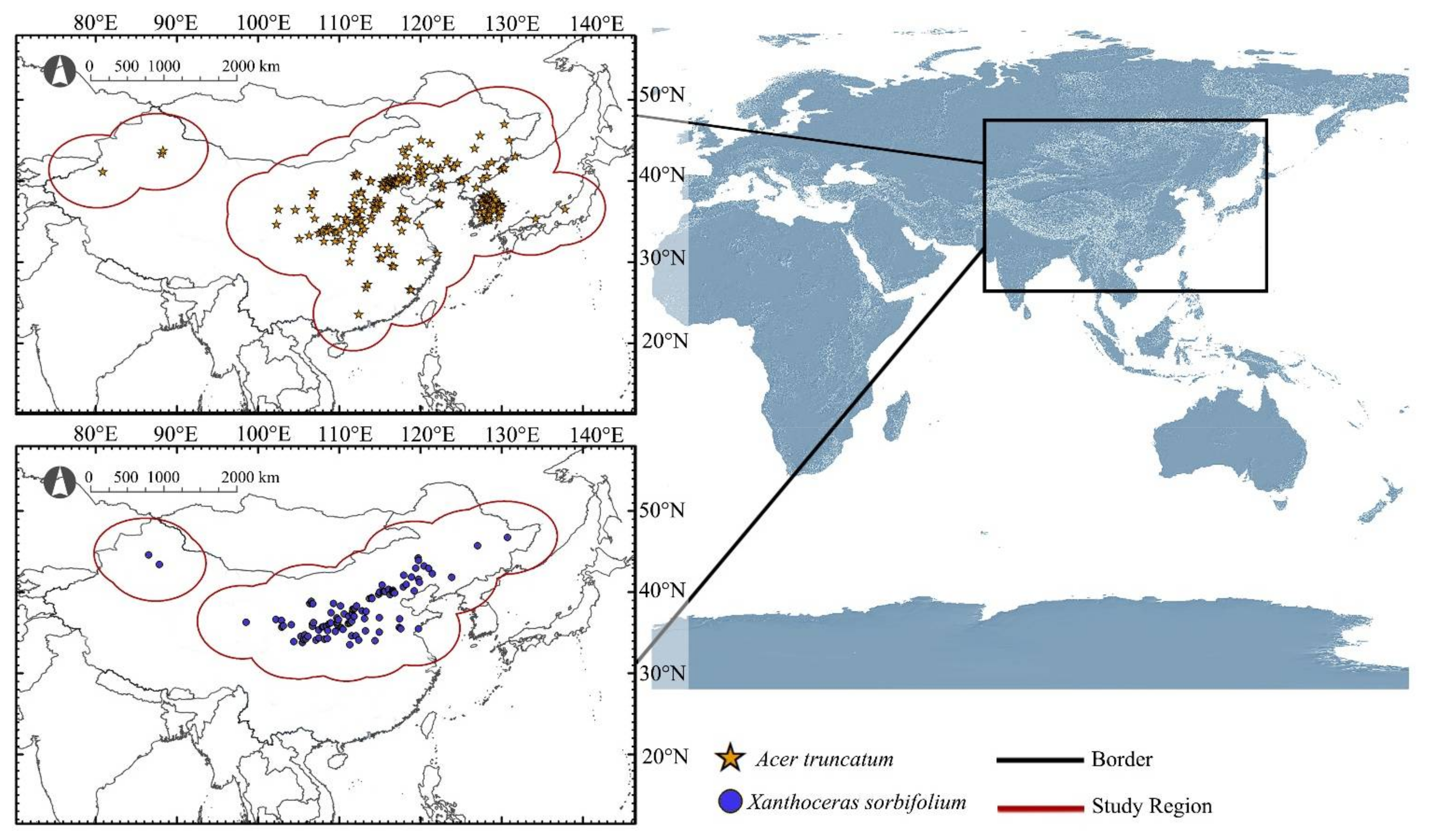
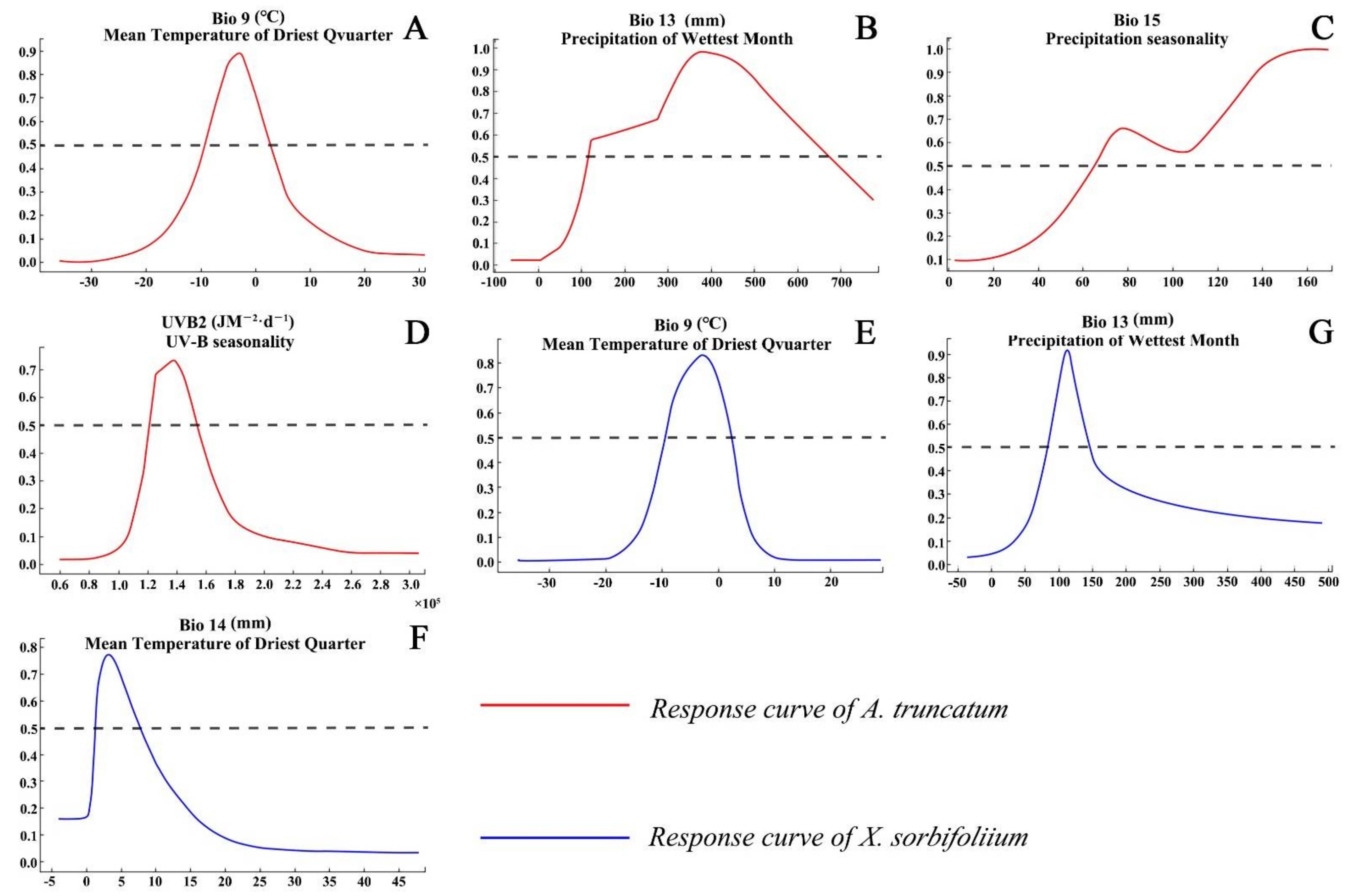
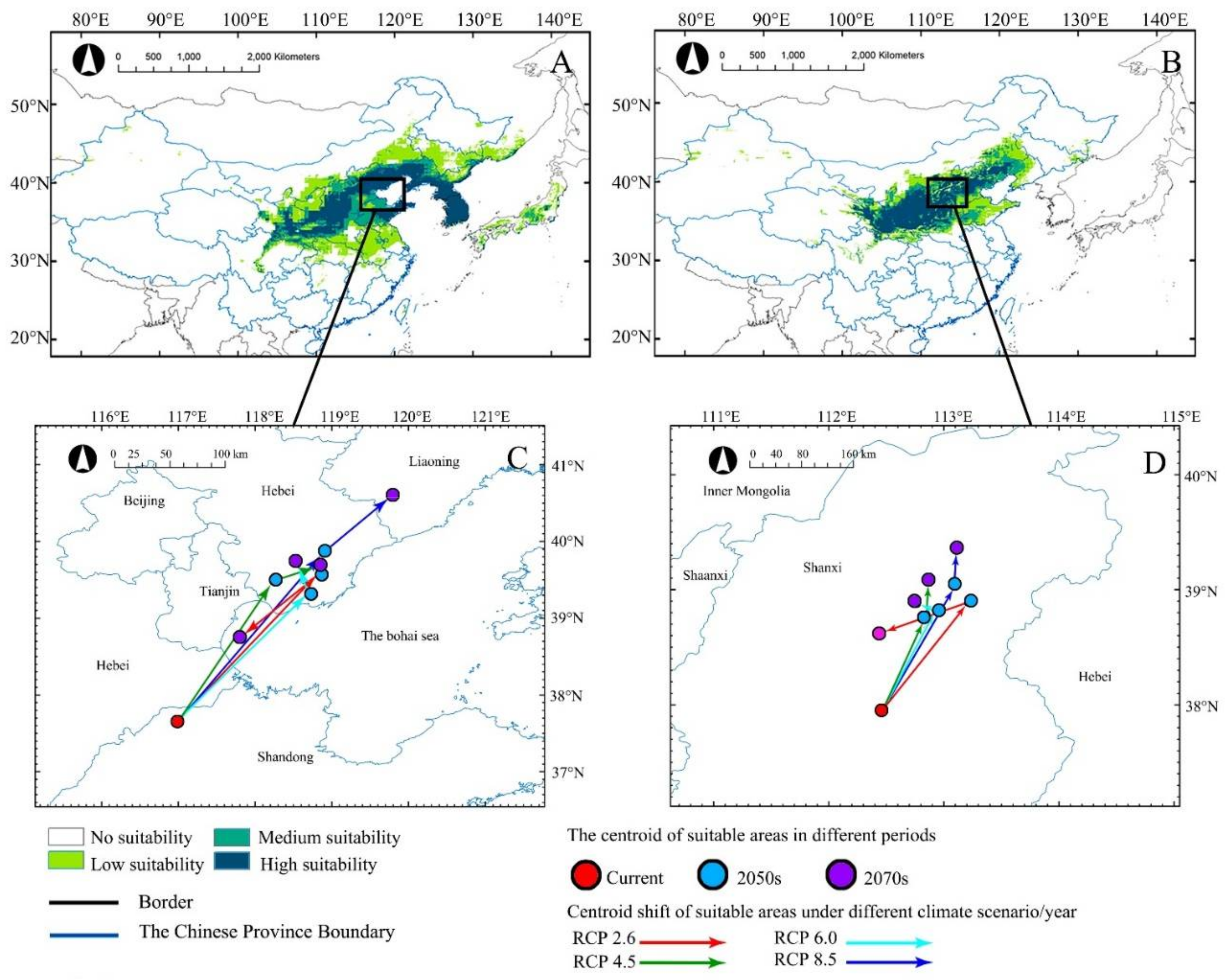
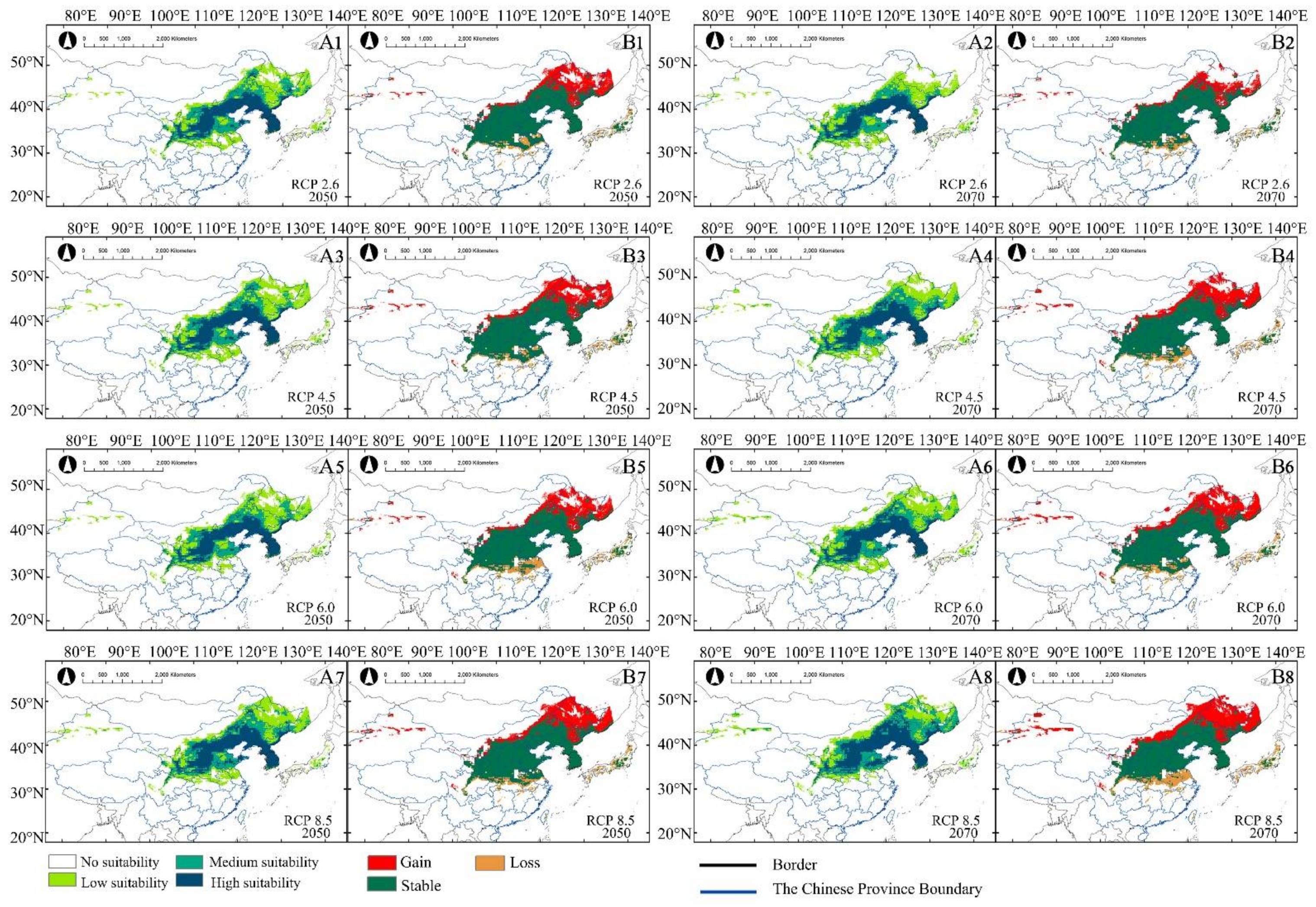
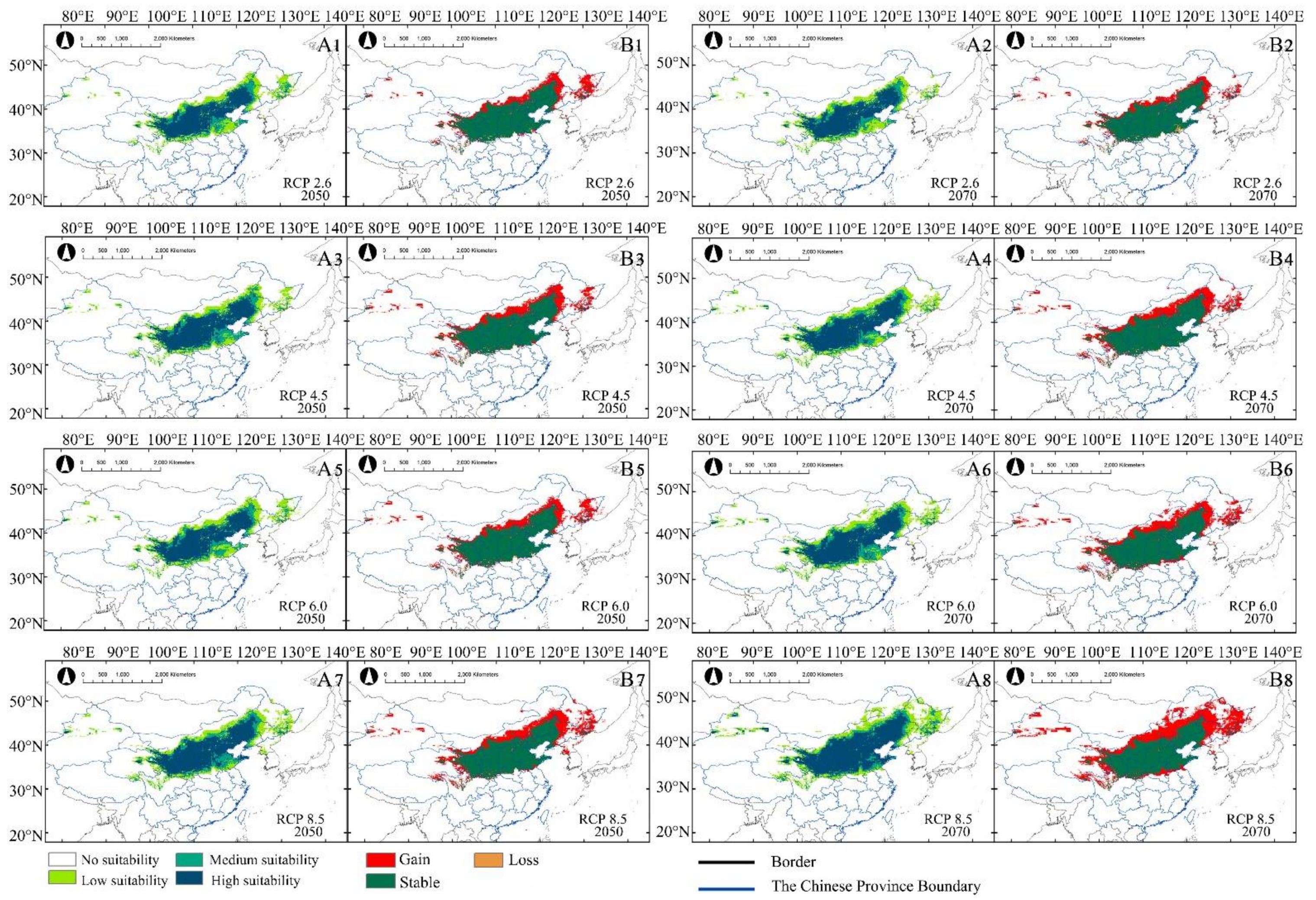
| A. truncatum | X. sorbifolium | ||||
|---|---|---|---|---|---|
| Symbol | Bioclimatic Variables | Contribution (%) | Permutation Importance (%) | Contribution (%) | Permutation Importance (%) |
| BIO2 | Mean Diurnal Range | 0.4 | 0.3 | 3.1 | 1.3 |
| BIO8 | Mean Temperature of Wettest Quarter | 0.4 | 0.5 | 2.3 | 11.2 |
| BIO9 | Mean Temperature of Driest Quarter | 41.5 | 30.7 | 33.8 | 27.5 |
| BIO13 | Precipitation of Wettest Month | 31.2 | 29.9 | 23.8 | 23.8 |
| BIO14 | Precipitation of Driest Month | × | × | 16 | 14.1 |
| BIO15 | Precipitation Seasonality (Coefficient of Variation) | 8.7 | 2.4 | 2.7 | 4.5 |
| BIO19 | Precipitation of Coldest Quarter | 1.4 | 1.4 | × | × |
| GDD | Growing Degree Days | 2.9 | 6 | 5.2 | 6.1 |
| SC | Soil Organic Carbon | 1.2 | 0.5 | 3.7 | 5.3 |
| SpH | Soil pH | 2.1 | 2.9 | 4.5 | 1.1 |
| VAP | Vapor Pressure | 1.2 | 3.3 | 1.3 | 2.3 |
| WET | Wet-Day Frequency | 1 | 11 | 1.8 | 2.3 |
| UVB-2 | UV-B Seasonality | 8 | 11 | 1.8 | 0.4 |
| A. truncatum (×104 km2) | X. sorbifolium (×104 km2) | |||||||
|---|---|---|---|---|---|---|---|---|
| High | Moderate | Low | Total | High | Moderate | Low | Total | |
| Current | 53.19 | 25.55 | 36.65 | 115.39 | 37.23 | 24.29 | 35.47 | 97 |
| RCP2.6—2050 | 65.89 | 43.23 | 47.96 | 157.08 | 44.37 | 28.94 | 60 | 133.31 |
| RCP2.6—2070 | 61.08 | 36.06 | 40.75 | 137.9 | 37.99 | 28.48 | 60.49 | 126.96 |
| RCP4.5—2050 | 66.17 | 41.32 | 46.64 | 154.12 | 48.55 | 31.38 | 66.36 | 146.29 |
| RCP4.5—2070 | 67.3 | 45.94 | 53.37 | 166.61 | 45.29 | 31.79 | 74.67 | 151.75 |
| RCP6.0—2050 | 65.9 | 36.82 | 45.54 | 148.26 | 44.28 | 28.42 | 64.86 | 137.56 |
| RCP6.0—2070 | 62.75 | 45.23 | 51.43 | 159.4 | 47.11 | 33.29 | 78.03 | 158.43 |
| RCP8.5—2050 | 72.4 | 42.45 | 52.94 | 167.79 | 48.61 | 34.97 | 77.22 | 160.8 |
| RCP8.5—2070 | 61.63 | 62.59 | 71.19 | 195.42 | 58.37 | 32.34 | 102.19 | 192.9 |
| A. truncatum (×104 km2) | X. sorbifolium (×104 km2) | |||||
|---|---|---|---|---|---|---|
| Gain | Stable | Loss | Gain | Stable | Loss | |
| RCP2.6—2050 | 45.84 | 111.24 | 4.15 | 37.56 | 95.74 | 1.26 |
| RCP2.6—2070 | 27.42 | 110.48 | 4.91 | 32.58 | 94.38 | 2.63 |
| RCP4.5—2050 | 44 | 110.12 | 5.27 | 49.49 | 96.8 | 0.2 |
| RCP4.5—2070 | 56.25 | 110.37 | 5.02 | 55.21 | 96.54 | 0.46 |
| RCP6.0—2050 | 39.75 | 108.51 | 6.87 | 41.43 | 96.13 | 0.87 |
| RCP6.0—2070 | 50.37 | 109.03 | 6.36 | 61.45 | 96.98 | 0.02 |
| RCP8.5—2050 | 58.56 | 109.23 | 6.16 | 63.82 | 96.98 | 0.03 |
| RCP8.5—2070 | 87.67 | 107.75 | 7.64 | 95.91 | 96.99 | 0.01 |
Publisher’s Note: MDPI stays neutral with regard to jurisdictional claims in published maps and institutional affiliations. |
© 2021 by the authors. Licensee MDPI, Basel, Switzerland. This article is an open access article distributed under the terms and conditions of the Creative Commons Attribution (CC BY) license (https://creativecommons.org/licenses/by/4.0/).
Share and Cite
Wu, Y.; Yang, Y.; Liu, C.; Hou, Y.; Yang, S.; Wang, L.; Zhang, X. Potential Suitable Habitat of Two Economically Important Forest Trees (Acer truncatum and Xanthoceras sorbifolium) in East Asia under Current and Future Climate Scenarios. Forests 2021, 12, 1263. https://doi.org/10.3390/f12091263
Wu Y, Yang Y, Liu C, Hou Y, Yang S, Wang L, Zhang X. Potential Suitable Habitat of Two Economically Important Forest Trees (Acer truncatum and Xanthoceras sorbifolium) in East Asia under Current and Future Climate Scenarios. Forests. 2021; 12(9):1263. https://doi.org/10.3390/f12091263
Chicago/Turabian StyleWu, Yaoxing, Yong Yang, Cheng Liu, Yixuan Hou, Suzhi Yang, Liangsheng Wang, and Xiuqing Zhang. 2021. "Potential Suitable Habitat of Two Economically Important Forest Trees (Acer truncatum and Xanthoceras sorbifolium) in East Asia under Current and Future Climate Scenarios" Forests 12, no. 9: 1263. https://doi.org/10.3390/f12091263
APA StyleWu, Y., Yang, Y., Liu, C., Hou, Y., Yang, S., Wang, L., & Zhang, X. (2021). Potential Suitable Habitat of Two Economically Important Forest Trees (Acer truncatum and Xanthoceras sorbifolium) in East Asia under Current and Future Climate Scenarios. Forests, 12(9), 1263. https://doi.org/10.3390/f12091263





